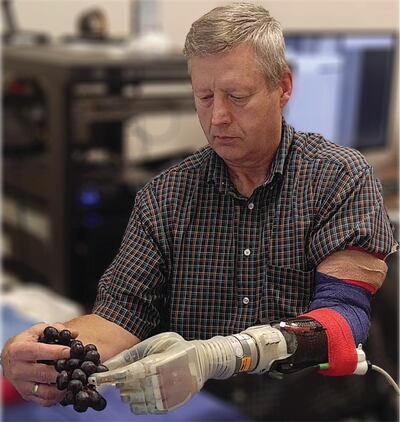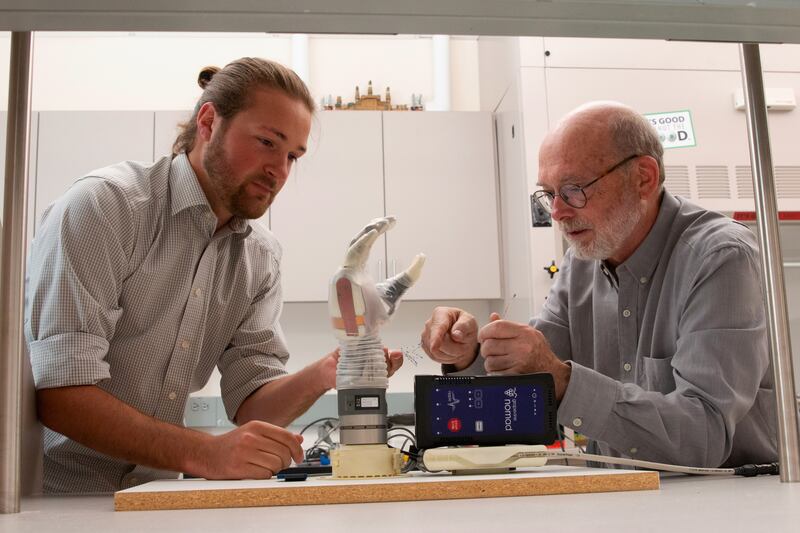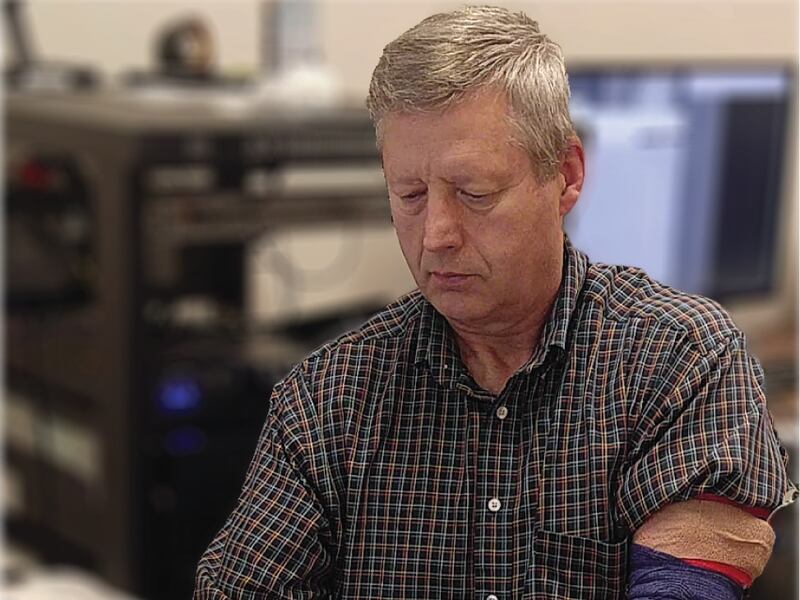SALT LAKE CITY — The line that separates an artificial hand from being just a "lump of metal and wires" to becoming a truly functional and integrated replacement — one that can carefully pick up and place a fragile uncooked egg or feel the reassuring grasp of a spouse's hand — is becoming harder to see (or sense) thanks to groundbreaking work coming out of the University of Utah.
And the biological/digital interface that U. professor Greg Clark's team has been improving — one made possible by an innovation that also came out of the state's flagship school in the 1990s — allows a high-tech prosthetic to not only be controlled by the wearer's thoughts but also feeds back a previously unattainable "touch sense."
Clark said the advancement adds a sensory feedback element to the use of an advanced bionic limb called the LUKE arm (so named after the robotic hand that Luke Skywalker got in "The Empire Strikes Back") "by using output from arm sensors to control stimulation of the sensory nerve fibers that convey information about the sense of touch to the brain."
"We showed that adding the sense of touch improved the user’s ability both to understand the environment and to control the movements of the artificial hand," Clark said. "We also showed that the more biologically realistic was the sensation, the better it worked."
The research was just published in a new paper co-authored by Clark, U. biomedical engineering doctoral student Jacob George, former doctoral student David Kluger and other colleagues in the latest edition of the journal Science Robotics.
Clark said while prosthetics themselves have made great advancements in recent years, the method for controlling them has changed little and hands, in particular, play a critical role in how people interact with the world around them.
"Exploring objects with our hands involves a rich interplay between making movements to manipulate an object and the sensations that result from making contact with the object," Clark said. "Traditional prosthetic hands lack sensory feedback, which makes them clumsy to control and makes them feel unnatural."
West Valley real estate agent Keven Walgamott was one of seven test subjects who had a chance to run the LUKE arm through its paces with the new sensory advancements. Walgamott lost the lower section of his left arm in an accident 13 years ago, and while he has used other, less advanced prosthetics, he described his experience with the U. team's innovation as "remarkable".

"It completely exceeded my expectations in what it was able to achieve," Walgamott said. "I didn’t think I would ever feel in that hand again. It was quite remarkable to feel sensations."
Walgamott said what he felt while using the hand didn't quite mimic the usual or natural feeling, but instead came through as "electrical impulses or little electric shocks". He said while he only had limited opportunity to work with the hand using the U.'s new sensory interface, he could envision how prolonged use could "begin to blur the line" between the biological self and the mechanical enhancement.
He also described a moment during the testing in which he took his wife Jill's hand with the advanced prosthetic.
"It was something I hadn't done in 13 years," Walgamott said."Being able to share that experience, not only being able to grasp her hand, but feel the hand of my wife was pretty special."
Walgamott and other test participants performed a number of different tasks, including picking grapes individually from a bunch, moving eggs and trying to differentiate soft and hard objects. Sensory information from the artificial hand feeds information via a device that connects directly to the wearer's nervous system. Walgamott, like the other participants, has a Utah Array implant, a block of a hundred very small, very finely pointed needles that connect directly to nerve endings. The device was developed through previous U. research headed by professor emeritus Richard Normann.
Clark explained that the signals from the sensors in the prosthetic are modified and then transmitted to the wearer via the array interface.
"We provided sensory feedback from the LUKE arm by electrically stimulating the user’s remaining arm nerves very precisely with electrodes that were previously implanted," Clark said. "The stimulation was driven by output from the arm’s sensors, passed through a computer to generate the appropriate activation patterns."
Clark said the sense of touch is a multilayered and complex set of interactions that create numerous challenges when it comes to trying to replicate the process, and feedback, in a system that melds the mechanical/electrical with the biological.
"When you touch objects with a natural hand, there’s an extra burst of neural impulses when you first make contact or when you change your grip force," Clark said. "Those extra neural signals make it easier for you to tell when changes are occurring.
"That’s the type of information that brain normally receives, so that’s what it finds easiest to interpret. So that’s also the type of information that we tried to send to the brain, by stimulating the remaining arm nerves in the right way. We provided information not only about pressure, but also about changes in pressure, and how fast those changes were changing."
Clark said the work outlined in the new paper has multiple potential applications, including for those with spinal injuries as well as other limb prosthetics. Work is also underway to make the whole system portable, via a belt-carried battery pack and computer processor.
Beside all of the practical and functional advancements the U.'s work could help actualize, Clark noted another factor that a restored sense of touch can bring, and it's one that Walgamott was able to experience when holding his wife's hand.
"The feeling of touch helps convey the feeling of closeness and of love," Clark said.



